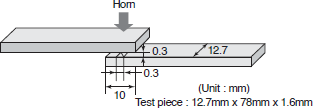- Home
- Product Information
- SUMIKAEXCEL PES
- Ultrasonic Welding
As SUMIKAEXCEL PES is an amorphous resin, an ultrasonic welding is relatively easy to perform if both pieces to be bonded are made of SUMIKAEXCEL PES. Three welding combinations are possible:
- Both pieces are non-reinforced grades
- A non-reinforced grade is to be bonded to a fiber reinforced grade
- Both pieces are fiber-reinforced grades
Case 1 is the easiest to accomplish and results in the greatest weld strength. However, cases 2 and 3 have adequate weld strengths and have better weld characteristics than crystalline resins (e.g., PPS).
The conditions for ultrasonic welding will vary depending on the output of the welding horn, the product shape, welding area, and grade. The standard conditions are as follows:
Table 5-3-1 Standard Conditions for Ultrasonic Welding
| Pressure (MPa) | 30-60 |
|---|---|
| Amplitude (μm) | 50-80 |
| Welding time (sec) | 0.1-2.0 |
Measurements of shear strength after ultrasonic welding are shown below. The test method and test pieces used are as follows:
Ultrasonic welder
SONOPET- 1200B (Seidensha Electronic Industry Co., Ltd.)
| Nominal output | : 1200W |
| Oscillation frequency | : 19.5kHz |
| Applied pressure | : 18N |
| Amplitude | : 34μm |
Figure 5-3-1 Test Piece for Shear Strength Measurement of Welded Area

Table 5-3-2 Maximum Load at Fracture of Welded Area (Tensile Shear Test)
(Unit : N)
| Oscillation time (sec) | |||
|---|---|---|---|
| 0.1 | 0.2 | 0.3 | |
| 3600G | 680 | 700 | Rupture outside the welded area |
| 3601GL20 | 660 | 850 | Rupture outside the welded area |
| 3601GL30 | 740 | 830 | Rupture outside the welded area |



